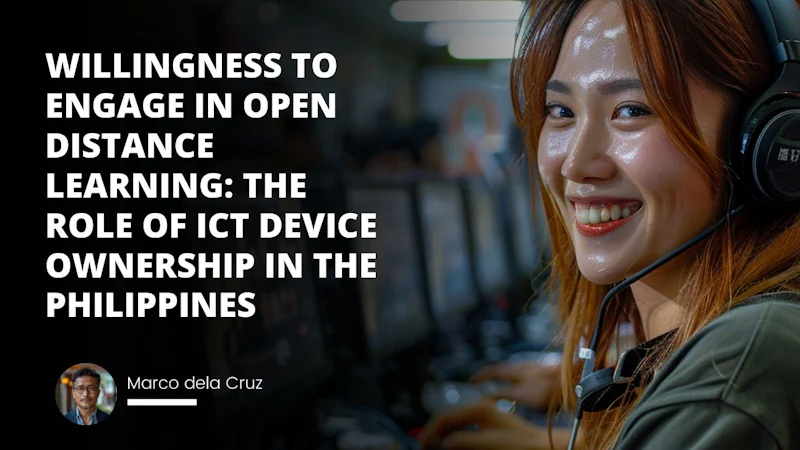The COVID-19 pandemic has brought about unprecedented challenges to education systems worldwide, forcing schools and universities to adopt open distance learning (ODL) as a means to ensure continuity in education. In the Philippines, this sudden shift has exposed the digital divide and highlighted the crucial role of information and communication technology (ICT) device ownership in enabling access to ODL. This blog post aims to explore the willingness to engage in online learning Philippines and how ICT device ownership influences this willingness, drawing upon data from the 2019 Functional Literacy, Education and Mass Media Survey conducted by the Philippine Statistics Authority (PSA).
The Landscape of ICT Device Ownership in the Philippines
Urban-Rural Divide
The PSA survey reveals that 96.1% of households in the Philippines own at least one ICT device, such as a personal computer, cellular phone, television, cable, radio, or broadband internet (Philippine Statistics Authority, 2019). However, a closer examination of the data uncovers a notable urban-rural divide in ICT device ownership:
Urban households: 97.1% own at least one ICT device
Rural households: 94.7% own at least one ICT device
This disparity suggests that rural households may face more challenges in accessing ODL due to limited ICT device ownership. The urban-rural divide in ICT device ownership can be attributed to various factors, including income disparities, infrastructure limitations, and digital literacy gaps. As Rotas and Cahapay (2020) point out, the digital divide in Philippine education is not merely a technological issue but also a socioeconomic one, with marginalized communities often lacking the resources and skills to fully participate in the digital economy.
Regional Disparities
The PSA data also reveals significant regional variations in ICT device ownership across the Philippines. While the National Capital Region (NCR) has the highest proportion of households with owned ICT devices at 99.1%, the Bangsamoro Autonomous Region in Muslim Mindanao (BARMM) has the lowest at 91.5% (Philippine Statistics Authority, 2019).
These regional disparities in ICT access Philippines highlight the need for targeted interventions to ensure equitable access to technology in Philippine schools nationwide. The differences in ICT device ownership across regions can be attributed to various factors, such as economic development, infrastructure, and cultural attitudes towards technology. For instance, the NCR, being the economic and political center of the country, has better access to ICT infrastructure and services compared to other regions. On the other hand, the BARMM, which has a history of conflict and underdevelopment, faces greater challenges in terms of ICT access and adoption.
Willingness to Engage in Open Distance Learning
Overall Willingness and Urban-Rural Differences
Despite the challenges posed by the digital divide, Filipinos have shown a strong willingness to engage in online learning Philippines. The PSA survey found that 82.4% of households are willing to participate in ODL, with 83.4% in urban areas and 81.1% in rural areas expressing their willingness (Philippine Statistics Authority, 2019).
This high level of willingness demonstrates the potential for ODL to expand access to education and training opportunities across the country. The slightly higher willingness in urban areas can be attributed to the greater availability of ICT devices and infrastructure, as well as exposure to digital technologies. However, the relatively high willingness in rural areas, despite the lower ICT device ownership, suggests that Filipinos recognize the value of education and are open to alternative learning modalities.
The Impact of ICT Device Ownership on ODL Willingness
Interestingly, the willingness to engage in ODL is higher among households with owned ICT devices compared to those without. The PSA data shows that 82.4% of households with owned ICT devices are willing to participate in ODL, while only 17.6% of households without owned ICT devices express the same willingness (Philippine Statistics Authority, 2019).
This finding underscores the importance of ICT device ownership in enabling access to ODL and highlights the need to address the digital divide in Philippine education to ensure inclusive education. The stark difference in ODL willingness between households with and without ICT devices can be explained by several factors. First, households with ICT devices are more likely to have the necessary tools and infrastructure to participate in ODL, such as computers, internet connectivity, and software. Second, exposure to ICT devices may contribute to greater digital literacy and confidence in using technology for learning. Finally, households with ICT devices may have higher levels of education and socioeconomic status, which are associated with greater willingness to engage in lifelong learning and alternative education modalities.
Addressing the Digital Divide for Inclusive ODL
The findings of the PSA survey underscore the urgent need to address the digital divide in Philippine education to ensure equitable access to ODL. While the overall willingness to engage in online learning Philippines is high, the disparities in ICT device ownership across urban-rural areas and regions, as well as the impact of ICT device ownership on education, highlight the importance of targeted interventions.
Invest in ICT infrastructure: Prioritize the development and expansion of ICT infrastructure, particularly in underserved rural areas and regions, to ensure reliable and affordable internet connectivity and access to digital devices.
Provide subsidies and incentives: Offer subsidies, grants, or low-interest loans to help low-income households acquire ICT devices and internet subscriptions, enabling them to participate in ODL.
Promote digital literacy: Implement digital literacy programs and training to equip Filipinos with the necessary skills and confidence to effectively use ICT devices for learning and other productive purposes.
Collaborate with the private sector: Foster public-private partnerships to leverage the expertise and resources of the private sector in developing and deploying ICT solutions for education, such as low-cost devices, educational software, and online learning platforms.
Develop inclusive ODL content: Ensure that ODL content and platforms are accessible, culturally relevant, and responsive to the diverse needs and contexts of learners, including those from marginalized communities and persons with disabilities.
Policy Recommendations
To bridge the digital divide and promote inclusive ODL, policymakers and stakeholders should consider the following recommendations:
1- Invest in ICT infrastructure: Prioritize the development and expansion of ICT infrastructure, particularly in underserved rural areas and regions, to ensure reliable and affordable internet connectivity and access to technology in Philippine schools.
Assess student needs: Conduct surveys and assessments to identify students' access to ICT devices, internet connectivity, and digital literacy levels, and provide targeted support and resources to those in need.
Provide device and connectivity support: Offer device lending programs, subsidized internet subscriptions, or on-campus computer labs to ensure that all students have access to the necessary tools for ODL.
Enhance faculty digital competencies: Invest in professional development programs to equip faculty members with the skills and knowledge to effectively design and deliver ODL, as well as to support students in the virtual learning environment.
Foster inclusive online learning communities: Create virtual spaces and activities that promote social interaction, collaboration, and peer support among students, mitigating the isolation and disconnection that may arise in ODL settings.
Continuously evaluate and improve: Regularly assess the effectiveness and inclusivity of ODL programs, gather feedback from students and faculty, and make data-driven improvements to ensure that ODL meets the evolving needs of diverse learners.
2- Provide subsidies and incentives: Offer subsidies, grants, or low-interest loans to help low-income households acquire ICT devices and internet subscriptions, enabling them to participate in ODL.
3- Promote digital literacy: Implement digital literacy programs Philippines and training to equip Filipinos with the necessary skills and confidence to effectively use ICT devices for learning and other productive purposes.
4- Collaborate with the private sector: Foster public-private partnerships to leverage the expertise and resources of the private sector in developing and deploying ICT solutions for education, such as low-cost devices, educational software, and online learning platforms.
5- Develop inclusive ODL content: Ensure that ODL content and platforms are accessible, culturally relevant, and responsive to the diverse needs and contexts of learners, including those from marginalized communities and persons with disabilities.
The Role of Academic Institutions
Academic institutions play a crucial role in promoting inclusive ODL and addressing the digital divide. As Toquero (2021) argues, higher education institutions in the Philippines must adapt to the new normal by embracing technology-mediated learning and ensuring that no student is left behind. To achieve this, academic institutions should:
Assess student needs: Conduct surveys and assessments to identify students' access to ICT devices, internet connectivity, and digital literacy levels, and provide targeted support and resources to those in need.
Provide device and connectivity support: Offer device lending programs, subsidized internet subscriptions, or on-campus computer labs to ensure that all students have access to the necessary tools for ODL.
Comprehensive Guide On Personal Development Skills And Strategies
Collaborative Planning Forecasting And Replenishment Benefits And İmplementation
Enhance faculty digital competencies: Invest in professional development programs to equip faculty members with the skills and knowledge to effectively design and deliver ODL, as well as to support students in the virtual learning environment.
Foster inclusive online learning communities: Create virtual spaces and activities that promote social interaction, collaboration, and peer support among students, mitigating the isolation and disconnection that may arise in ODL settings.
Continuously evaluate and improve: Regularly assess the effectiveness and inclusivity of ODL programs, gather feedback from students and faculty, and make data-driven improvements to ensure that ODL meets the evolving needs of diverse learners.
Conclusion
The COVID-19 pandemic has accelerated the adoption of open distance learning in the Philippines, exposing the digital divide and emphasizing the critical role of ICT device ownership in enabling access to ODL. While Filipinos have shown a strong willingness to engage in online learning Philippines, the urban-rural divide and regional disparities in ICT access Philippines pose significant challenges in ensuring equitable access to ODL opportunities.
Addressing the digital divide in Philippine education requires a concerted effort from policymakers, academic institutions, and the private sector. By investing in ICT infrastructure, providing subsidies and incentives, promoting digital literacy programs Philippines, collaborating with the private sector, and developing inclusive ODL content, we can bridge the gap and ensure that all Filipinos, regardless of their location or socioeconomic background, can access quality education and training through ODL.
As an educator who has witnessed the struggles and resilience of students during the pandemic, I believe that the shift to ODL is not just a temporary response but a transformative opportunity to build a more equitable, inclusive, and future-ready education system in the Philippines. By harnessing the power of technology and addressing the digital divide, we can create a learning ecosystem that empowers all Filipinos to thrive in the face of adversity and pursue their dreams.
One of my students, Maria, hails from a remote village in the Cordillera region. When the pandemic forced schools to close, Maria faced numerous challenges in accessing ODL. Her family did not own a computer or have a reliable internet connection, and the nearest internet café was a two-hour walk from her home. Despite these obstacles, Maria's determination to continue her education was unwavering. She would wake up at 4 am every day to make the long journey to the internet café, where she would spend hours attending online classes and completing assignments. Maria's story is a testament to the resilience and dedication of Filipino students in the face of adversity, and it underscores the urgent need to address the digital divide in Philippine education.
The government has taken some steps to bridge the digital divide, such as the Department of Education's Learning Continuity Plan, which aims to provide access to learning resources and support for students and teachers during the pandemic (Department of Education, 2020). However, much more needs to be done to ensure that all students, particularly those from marginalized communities, have equitable access to ODL. This requires a multi-stakeholder approach that involves collaboration between the government, academic institutions, the private sector, and civil society organizations.
One promising initiative is the Digital Farmers Program, a partnership between the Department of Agriculture and the Technical Education and Skills Development Authority (TESDA), which aims to provide digital literacy training and access to ICT devices for farmers and rural communities (Department of Agriculture, 2021). By equipping rural households with the necessary skills and tools to participate in the digital economy, programs like these can help bridge the urban-rural divide in ICT device ownership and promote inclusive ODL.
Academic institutions also have a crucial role to play in promoting inclusive ODL. For example, the University of the Philippines Open University (UPOU) has been at the forefront of providing accessible and quality ODL programs for over two decades (Alfonso, 2014). UPOU's model of ODL emphasizes flexibility, self-paced learning, and the use of various media and technologies to deliver instruction. By adapting this model to the current context and scaling up its reach, other higher education institutions can help ensure that no student is left behind in the shift to ODL.
Ultimately, the goal of inclusive ODL is not just to ensure access to education during the pandemic, but to build a more resilient and equitable education system for the future. As Cosentino (2013) argues, an inclusive education system is one that values diversity, promotes participation and collaboration, and provides support for all learners to reach their full potential. By addressing the digital divide and promoting inclusivity in ODL, we can lay the foundation for a more just and sustainable education system that prepares Filipinos for the challenges and opportunities of the 21st century.
In conclusion, the COVID-19 pandemic has exposed the digital divide in Philippine education and highlighted the urgent need to promote inclusive ODL. While Filipinos have shown a strong willingness to engage in online learning Philippines, the impact of ICT device ownership on education and the urban-rural divide in ICT device ownership pose significant challenges in ensuring equitable access to ODL opportunities. Addressing these challenges requires a multi-stakeholder approach that involves policies for inclusive education in the Philippines, investments in education infrastructure in rural areas, digital literacy programs Philippines, and the active participation of academic institutions in promoting accessible and quality ODL. By working together to bridge the digital divide, we can build a more inclusive, resilient, and future-ready education system that empowers all Filipinos to thrive in the face of adversity and pursue their dreams.
References
Alfonso, G. J. (2014). UP Open University: Thoughts about openness in a digitized world. University of the Philippines Open University.
Cosentino, S. (2013). The right to inclusive education: A rights-based approach. In V. Della Fina & R. Cera (Eds.), Protecting the rights of people with autism in the fields of education and employment (pp. 105-124). Springer.
Department of Agriculture. (2021). DA, TESDA partner to provide digital skills training for farmers. https://www.da.gov.ph/da-tesda-partner-to-provide-digital-skills-training-for-farmers/
Department of Education. (2020). Learning Continuity Plan in the time of COVID-19. https://www.deped.gov.ph/wp-content/uploads/2020/07/DepEd-LCP-1.pdf
Philippine Statistics Authority. (2019). 2019 Functional Literacy, Education and Mass Media Survey. https://psa.gov.ph/flemms
Rotas, E. E., & Cahapay, M. B. (2020). Difficulties in remote learning: Voices of Philippine university students in the wake of COVID-19 crisis. Asian Journal of Distance Education, 15(2), 147-158.
Toquero, C. M. (2021). Emergency remote education experiment amid COVID-19 pandemic. International Journal of Educational Research and Innovation, 15, 162-176.





